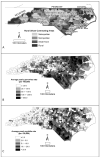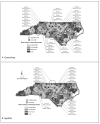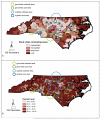Does core area theory apply to sexually transmitted diseases in rural environments?
- PMID: 23254115
- PMCID: PMC3528791
- DOI: 10.1097/OLQ.0b013e3182762524
Does core area theory apply to sexually transmitted diseases in rural environments?
Abstract
Background: Our objective was to determine the extent to which geographical core areas for gonorrhea and syphilis are located in rural areas as compared with urban areas.
Methods: Incident gonorrhea (January 1, 2005-December 31, 2010) and syphilis (January 1, 1999-December 31, 2010) rates were estimated and mapped by census tract and quarter. Rurality was measured using percent rural and rural-urban commuting area (rural, small town, micropolitan, or urban). SaTScan was used to identify spatiotemporal clusters of significantly elevated rates of infection. Clusters lasting 5 years or longer were considered core areas; clusters of shorter duration were considered outbreaks. Clusters were overlaid on maps of rurality and qualitatively assessed for correlation.
Results: Twenty gonorrhea core areas were identified: 65% were in urban centers, 25% were in micropolitan areas, and the remaining 10% were geographically large capturing combinations of urban, micropolitan, small town, and rural environments. Ten syphilis core areas were identified with 80% in urban centers and 20% capturing 2 or more rural-urban commuting areas. All 10 (100%) of the syphilis core areas overlapped with gonorrhea core areas.
Conclusions: Gonorrhea and syphilis rates were high for rural parts of North Carolina; however, no core areas were identified exclusively for small towns or rural areas. The main pathway of rural sexually transmitted disease (STI) transmission may be through the interconnectedness of urban, micropolitan, small town, and rural areas. Directly addressing STIs in urban and micropolitan communities may also indirectly help address STI rates in rural and small town communities.
Figures




References
-
- Yorke JA, Hethcote HW, Nold A. Dynamics and control of the transmission of gonorrhea. Sex Transm Dis. 1978;5(2):51–6. - PubMed
-
- Rothenberg RB. The geography of gonorrhea. Empirical demonstration of core group transmission. Am J Epidemiol. 1983;117(6):688–94. - PubMed
-
- Alvarez-Dardet C, Marquez S, Perea EJ. Urban clusters of sexually transmitted diseases in the city of Seville, Spain. Sex Transm Dis. 1985;12(3):166–8. - PubMed
-
- Becker KM, Glass GE, Brathwaite W, et al. Geographic epidemiology of gonorrhea in Baltimore, Maryland, using a geographic information system. Am J Epidemiol. 1998;147(7):709–16. - PubMed
-
- Bernstein KT, Curriero FC, Jennings JM, et al. Defining core gonorrhea transmission utilizing spatial data. Am J Epidemiol. 2004;160(1):51–8. - PubMed
Publication types
MeSH terms
Grants and funding
LinkOut - more resources
Full Text Sources
Other Literature Sources
Medical

